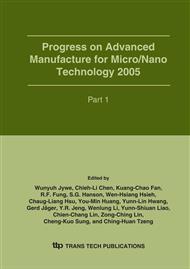[1]
Preston, F., J. Soc. Glass Technol., 11 (1927), p.214.
Google Scholar
[2]
Cook, L. M., J. Non-Crystal Solids, 120 (1990), p.152.
Google Scholar
[3]
Nanz, G. and Camilletti, L. E., IEEE Trans, Semiconductor Manufacturing, 8 (1995), p.382.
Google Scholar
[4]
Bhushan, M., Rouse, R., and Lukens, J. E., J. Electrochem. Soc., 142 (1995), p.3845.
Google Scholar
[5]
Chekina, O. G., Keer, L. M., and Liang, H., J. Electrochem. Soc., 145 (1998), p.2100.
Google Scholar
[6]
Tseng, W. -T., Wang, Y. -H., and Chin, J. -H., J. Electrochem. Soc., 146 (1999), p.4273.
Google Scholar
[7]
Zhao, Y. and Chang, L., Wear, 252 (2002), p.220.
Google Scholar
[8]
Runnels, S. R. and Eyman, L. M., J. Electrochem. Soc., 141 (1994), p.1698.
Google Scholar
[9]
Runnels, S. R., J. Electrochem. Soc., 141 (1994), p. (1900).
Google Scholar
[10]
Chen, J. M. and Fang, Y. C., IEEE Trans, Semiconductor Manufacturing, 15 (2002), p.39.
Google Scholar
[11]
Sundararajan, S., Thakurta, D. G., Schwendeman, D. W., Murarka, S. P., and Gill, W. N., J. Electrochem. Soc., 146 (1999), p.761.
Google Scholar
[12]
Thakurta, D. G., Borst, C. L., Schwendeman, D. W., Gutmann, R. J., and Gill, W. N., Thin Solid Films, 336 (2000), p.181.
Google Scholar
[13]
Liang, H., Kaufman, F., Sevilla, R., and Anjur, S., Wear, 211 (1997), p.271.
Google Scholar
[14]
Lu, J., Coppeta, J., Rogers, C., Racz, L., Philipossian, A., Moinpour, A., and Kaufman, F., Mater. Res. Soc. Symp. Proc., San Francisco, 613 (2000), p. E1. 2. 1.
Google Scholar
[15]
Haff, P. K., J. Fluid Mech. 134 (1983), p.401.
Google Scholar
[16]
Dai, F., Khonsari, M. M. and Lu, Y. Z., Tribol. Trans., 37 (1994), p.516.
Google Scholar
[17]
Heshmat, H., Lubri. Eng., 48 (1992), p.373.
Google Scholar
[18]
Jeng, Y. R. and Tsai, H. J., J. Phys. D: Appl. Phys., 35 (2002), p.1585.
Google Scholar
[19]
Patir, N. and Cheng, H. S., ASME J. Lubri. Technol., 100 (1978), p.12.
Google Scholar
[20]
Patir, N. and Cheng, H. S., ASME J. Lubri. Technol., 101 (1979), p.220.
Google Scholar
[21]
Tripp, J. H., ASME J. Lubri. Technol., 105 (1983), p.458.
Google Scholar
[22]
Tsai, H. J. and Jeng, Y. R., ASME J. Tribol., 124 (2002), p.736.
Google Scholar
[23]
Jeng, Y. R. and Tsai, H. J., J. Electrochem. Soc., 150, 6 (2003), p. G348.
Google Scholar
[24]
Jeng, Y. R. and Tsai, H. J., ASME J. Tribol., 127 (2005), in press.
Google Scholar
[25]
Yu, C. M., Craig, K., and Tichy, J., J. Rheol. 38, 4 (1994), p.921.
Google Scholar
[26]
Tseng, W. -T., Chin, J. -H., and Kang, L. -C., J. Electrochem. Soc., 146 (1999), p. (1952).
Google Scholar


